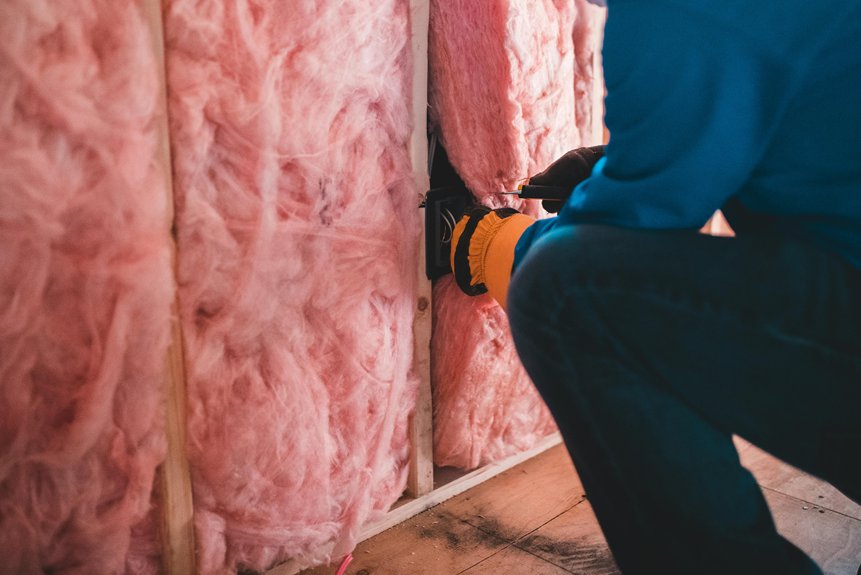EPD insulation is a high-performance material that is highly regarded for its outstanding thermal resistance, durability, and eco-friendliness. It boasts a significant R-value, remains stable over time, and is resistant to moisture, making it an ideal choice for walls, roofs, and foundations.
Lightweight and straightforward to install, EPD insulation contributes to enhanced energy efficiency and helps to reduce costs. However, it is important to note that it is non-biodegradable and can release harmful chemicals if not managed appropriately.
A deeper exploration into EPD insulation reveals how its advantages and environmental considerations influence its application in the construction sector.
Benefits of EPD Insulation in Building Projects
EPD insulation presents a range of significant advantages for building projects, making it a preferred option for both residential and commercial construction in the UK.
It offers a high R-value relative to cost, ensuring that thermal performance remains economically viable throughout its lifespan. With its low thermal conductivity, EPD insulation effectively minimises heat loss during winter months and heat gain in summer, contributing to comfortable indoor environments while reducing energy expenses.
Moreover, the stable R-value of EPD ensures that its efficiency is maintained over time, eliminating the need for frequent replacements. Its cost-effectiveness makes it an attractive choice for budget-conscious projects without compromising on quality.
The lightweight nature and adaptable forms of EPD insulation facilitate quicker installation, which can dramatically reduce labour time. Additionally, its closed-cell structure provides excellent moisture resistance, helping to prevent issues such as mould growth and water damage, thereby supporting the longevity of buildings.
Furthermore, EPD insulation is recyclable and free from harmful chemicals, promoting environmentally responsible construction practices. This not only benefits the planet but also enhances the wellbeing of building occupants.
Key Properties and Performance Features of EPD Insulation
The key properties of EPD insulation, such as its thermal resistance and physical durability, establish it as a dependable choice in construction. The consistent R-values derive from a closed-cell structure that’s filled with stabilised air, which effectively resists ageing and freeze-thaw damage. Additionally, EPS is composed of 98-99% air by volume, which significantly reduces heat transfer and enhances insulation performance. This high air content not only contributes to its excellent insulating properties but also allows it to maintain its performance over many years without degradation. High air content
Key features include:
- High thermal resistance, with R-values that outperform many comparable materials.
- Long-term stability, ensuring that both physical and insulating properties are maintained over decades, even in challenging environments.
- Moisture resistance and environmental safety, characterised by limited water absorption and the absence of harmful chemicals, which supports indoor air quality.
Collectively, these attributes make EPD insulation a trusted and efficient choice for building projects across the UK.
Common Applications and Installation Tips for EPD Insulation
Due to its versatile properties, EPS insulation is widely used in various aspects of construction, providing excellent thermal performance and durability.
It’s commonly employed for insulating walls, roofs, and floors, effectively reducing heat transfer and lowering energy expenses in residential and commercial buildings.
Additionally, EPS insulation is ideal for foundation applications, helping to stabilise soil temperatures and prevent frost damage, particularly in colder climates.
It’s also utilised in structural insulated panels (SIPs), which combine insulation with structural support, and serves as a lightweight fill material in projects involving roads, railways, and landscaping.
In marine contexts, EPS finds use in buoyant materials such as pontoons and marina floats, owing to its moisture resistance.
For installation, EPS insulation can be easily cut and shaped to fit irregular spaces, facilitating quick and efficient construction.
It’s crucial to implement proper moisture management and protective coverings during installation to ensure optimal performance and longevity.
EPS’s exceptional moisture resistance allows it to maintain insulation properties even in damp environments, extending its effective lifespan.
Environmental Impact and Sustainability of EPD Insulation
Although EPS insulation provides numerous energy-saving advantages, its environmental impact raises concerns due to its long-lasting presence in the natural world. EPS is non-biodegradable, often persisting for centuries and fragmenting into microplastics that can pollute ecosystems. It has the potential to leach harmful chemicals such as styrene and benzene into soil and water, posing risks to groundwater quality. Wildlife may inadvertently ingest EPS fragments, leading to internal injuries or fatalities, and these pollutants can bioaccumulate in the food chain, ultimately affecting human health. EPS is also resistant to degradation, which means its environmental impact remains for a very long time if not properly managed. However, it’s important to note that EPS has a considerably lower ozone depletion potential (ODP) and global warming potential (GWP) when compared to other foam insulation options like XPS. Its production process is designed to minimise the release of harmful greenhouse gases, thereby reducing the overall environmental footprint. Moreover, recycling initiatives play a vital role in minimising waste and decreasing the demand for virgin materials, which supports broader sustainability efforts. By embracing these practices, the insulation sector can contribute to a more environmentally conscious future.
Conclusion
EPD insulation provides a multitude of advantages, including exceptional thermal performance, durability, and eco-friendliness. Its key characteristics render it ideal for various building applications, enhancing energy efficiency and minimising environmental impact.
Proper installation is crucial to ensure maximum effectiveness and safety. Ultimately, EPD insulation stands out as a dependable choice for sustainable construction, merging high performance with environmentally conscious attributes.
Its versatility and ecological benefits present it as a valuable option for contemporary building projects in the UK.

